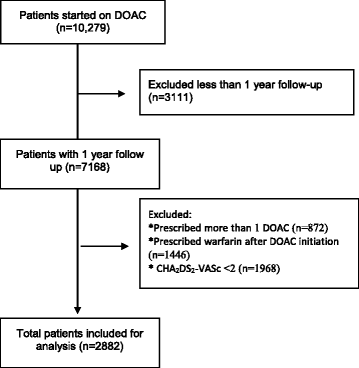Adherence and outcomes to direct oral anticoagulants among patients with atrial fibrillation: findings from the veterans health administration
- PMID: 28865440
- PMCID: PMC5581418
- DOI: 10.1186/s12872-017-0671-6
Adherence and outcomes to direct oral anticoagulants among patients with atrial fibrillation: findings from the veterans health administration
Abstract
Background: The direct oral anticoagulants (DOACs) reduce the risk of stroke in moderate to high-risk patients with non-valvular atrial fibrillation (AF). Yet, concerns remain regarding its routine use in real world practice. We sought to describe adherence patterns and the association between adherence and outcomes to the DOACs among outpatients with AF.
Methods: We performed a retrospective cohort study of patients in the VA Healthcare System who initiated pharmacotherapy with dabigatran, rivaroxaban, or apixaban between November 2010 and January 2015 for non-valvular AF with CHA2DS2-VASc score ≥ 2. Adherence was determined using pharmacy refill data and estimated by the proportion of days covered (PDC) over the first year of therapy. Clinical outcomes, including all-cause mortality and stroke, were measured at 6 months and used to assess measures of adherence for each DOAC.
Results: A total of 2882 patients were included. Most were prescribed dabigatran (72.7%), compared with rivaroxaban (19.8%) or apixaban (7.5%). The mean PDC was 0.84 ± 0.20 for dabigatran, 0.86 ± 0.18 for rivaroxaban, and 0.89 ± 0.14 for apixaban (p < 0.01). The proportion of non-adherent patients, PDC <0.80, was 27.6% for all and varied according DOAC. Lower adherence to dabigatran was associated with higher risk of mortality and stroke (HR 1.07; 1.03-1.12 per 0.10 decline in PDC).
Conclusions: In a real-world VA population being prescribed anticoagulation for AF, more than one quarter had sub-optimal adherence. Lower adherence was associated with a higher risk of mortality and stroke. Efforts identifying non-adherent patients, and targeted adherence interventions are needed to improve outcomes.
Keywords: Atrial fibrillation; Direct oral anticoagulants; Medication adherence.
Conflict of interest statement
Ethics approval and consent to participate
This study received approval from the Colorado Multiple Institutional Review Board (IRB 12–0347).
Consent for publication
Not applicable.
Competing interests
PMH is the deputy editor of Circulation: Cardiovascular Quality and Outcomes journal and serves in the steering committee for Janssen, Inc. trial t6o improve adherence to DOACs. There are otherwise no conflicts for all other others pertaining to the work.
Publisher’s Note
Springer Nature remains neutral with regard to jurisdictional claims in published maps and institutional affiliations.
Figures
Similar articles
-
Real-world adherence for direct oral anticoagulants in a newly diagnosed atrial fibrillation cohort: does the dosing interval matter?BMC Cardiovasc Disord. 2019 Mar 19;19(1):64. doi: 10.1186/s12872-019-1033-3. BMC Cardiovasc Disord. 2019. PMID: 30890131 Free PMC article.
-
Comparative safety and effectiveness of dabigatran vs. rivaroxaban and apixaban in patients with non-valvular atrial fibrillation: a retrospective study from a large healthcare system.Eur Heart J Cardiovasc Pharmacother. 2019 Apr 1;5(2):80-90. doi: 10.1093/ehjcvp/pvy044. Eur Heart J Cardiovasc Pharmacother. 2019. PMID: 30500885 Free PMC article.
-
Apixaban, Rivaroxaban, and Dabigatran in Patients Undergoing Atrial Fibrillation Ablation.J Cardiovasc Electrophysiol. 2016 Feb;27(2):147-53. doi: 10.1111/jce.12856. Epub 2015 Nov 23. J Cardiovasc Electrophysiol. 2016. PMID: 26464027
-
Direct comparative effectiveness and safety between non-vitamin K antagonist oral anticoagulants for stroke prevention in nonvalvular atrial fibrillation: a systematic review and meta-analysis of observational studies.Eur J Epidemiol. 2019 Feb;34(2):173-190. doi: 10.1007/s10654-018-0415-7. Epub 2018 Jun 8. Eur J Epidemiol. 2019. PMID: 29948370
-
Non-Vitamin K Antagonist Oral Anticoagulants and Factors Influencing the Ischemic and Bleeding Risk in Elderly Patients With Atrial Fibrillation: A Review of Current Evidence.J Cardiovasc Pharmacol. 2020 Oct 14;77(1):11-21. doi: 10.1097/FJC.0000000000000927. J Cardiovasc Pharmacol. 2020. PMID: 33060545 Free PMC article. Review.
Cited by
-
Contemporary clinical and economic outcomes among oral anticoagulant treated and untreated elderly patients with atrial fibrillation: Insights from the United States Medicare database.PLoS One. 2022 Feb 17;17(2):e0263903. doi: 10.1371/journal.pone.0263903. eCollection 2022. PLoS One. 2022. PMID: 35176074 Free PMC article.
-
Adherence to oral anticoagulants among patients with atrial fibrillation: a systematic review and meta-analysis of observational studies.BMJ Open. 2020 Apr 8;10(4):e034778. doi: 10.1136/bmjopen-2019-034778. BMJ Open. 2020. PMID: 32273316 Free PMC article.
-
Adherence to Anticoagulation and Risk of Stroke Among Medicare Beneficiaries Newly Diagnosed with Atrial Fibrillation.Am J Cardiovasc Drugs. 2020 Apr;20(2):199-207. doi: 10.1007/s40256-019-00371-3. Am J Cardiovasc Drugs. 2020. PMID: 31523759 Free PMC article.
-
Design and rationale of DUTCH-AF: a prospective nationwide registry programme and observational study on long-term oral antithrombotic treatment in patients with atrial fibrillation.BMJ Open. 2020 Aug 24;10(8):e036220. doi: 10.1136/bmjopen-2019-036220. BMJ Open. 2020. PMID: 32843516 Free PMC article.
-
Integrated Care in Atrial Fibrillation: A Road Map to the Future.Circ Cardiovasc Qual Outcomes. 2021 Mar;14(3):e007411. doi: 10.1161/CIRCOUTCOMES.120.007411. Epub 2021 Mar 5. Circ Cardiovasc Qual Outcomes. 2021. PMID: 33663224 Free PMC article. Review.
References
-
- Connolly SJ, Ezekowitz MD, Yusuf S, Eikelboom J, Oldgren J, Parekh A, Pogue J, TE RPAV, Wang S, Alings M, Xavier D, Zhu J, Diaz R, Lewis BS, Darius H, Diener HC, Joyner CD, Wallentin L, RE-LY Steering Committee and Investigators Dabigatran versus warfarin in patients with atrial fibrillation. N Engl J Med. 2009;361(12):1139. doi: 10.1056/NEJMoa0905561. - DOI - PubMed
-
- Granger CB, Alexander JH, McMurray JJ, Lopes RD, Hylek EM, Hanna M, Al-Khalidi HR, Ansell J, Atar D, Avezum A, Bahit MC, Diaz R, Easton JD, Ezekowitz JA, Flaker G, Garcia D, Geraldes M, Gersh BJ, Golitsyn S, Goto S, Hermosillo AG, Hohnloser SH, Horowitz J, Mohan P, Jansky P, Lewis BS, Lopez-Sendon JL, Pais P, Parkhomenko A, Verheugt FW, Zhu J, Wallentin L, ARISTOTLE Committees and Investigators Apixaban versus Warfarin in patients with Atrial fibrillation. N Engl J Med. 2011;365(11):981. doi: 10.1056/NEJMoa1107039. - DOI - PubMed
-
- Patel MR, Mahaffrey KW, Garg J, Pan G, Singer DE, Hacke W, Breithardt G, Halperin JL, Hankey GJ, Piccini JP, Becker RC, Nessel CC, Paolini JF, Berkowitz SD, Fox KA, Califf RM, ROCKET AF Investigators Rivaroxaban versus Warfarin in Nonvalvular Atrial fibrillation. N Engl J Med. 2011;365(10):883. doi: 10.1056/NEJMoa1009638. - DOI - PubMed
MeSH terms
Substances
LinkOut - more resources
Full Text Sources
Other Literature Sources
Medical


